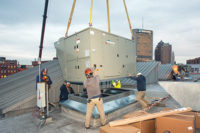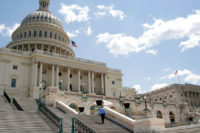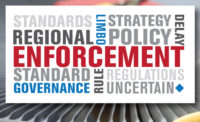On Dec. 17, 2015, the U.S. Department of Energy (DOE) finalized new negotiated energy conservation standards for commercial air conditioners and heat pumps and commercial warm-air furnaces, otherwise known as rooftop units (RTUs). The department estimates the new efficiency standards for RTUs will save businesses as much as $167 billion in energy costs over the lifetime of the equipment — more than any other efficiency standard issued to date. Additionally, carbon pollution will be reduced enough over the next 30 years to offset the annual carbon dioxide emissions of more than 120 million homes.
This announcement “marks the largest energy-saving standard in history and demonstrates that America is leading the effort to reduce energy costs and cut carbon emissions,” said Ernest Moniz, U.S. energy secretary. “This rule also shows that strong public-private partnerships can reap environmental and economic dividends and drive technology breakthroughs.”
“These groundbreaking standards will yield the greatest single amount of energy savings of any rule ever issued by the DOE,” said Rhea Suh, president of the Natural Resources Defense Council (NRDC). “They will save about the same amount of energy as all the coal burned in the U.S. to generate electricity in a year — a huge reduction in carbon pollution. And, like in Paris, where the community of nations made history by banding together to fight climate change [by adopting the Paris Agreement on Dec. 12, 2015], these historic efficiency standards were the result of an accord reached by stakeholders who set aside their competing interests for the common good.”
STAKEHOLDER SUPPORT
The DOE’s announcement comes nearly four months after the 17 stakeholders comprising the Commercial Package Air Conditioners and Heat Pumps and Commercial Warm Air Furnaces Working Group provided consensus recommendations for energy conservation standards, test procedures, and metrics to the Appliance Standards and Rulemaking Federal Advisory Committee (ASRAC). Stephen Yurek, president and CEO of the Air-Conditioning, Heating, and Refrigeration Institute (AHRI), which participated in the working group, praised the DOE-convened negotiation process that brought together representatives of individual manufacturers, installers, utilities, environmental groups, and efficiency organizations (see sidebar for full list of participants).
“The consensus agreement provides our members with certainty while providing benefits for consumers and businesses,” Yurek said.
Andrew deLaski, executive director of the Appliance Standards Awareness Project (ASAP), also lauded the DOE’s direct final rule’s monumental energy and economic savings.
“Huge energy-bill savings, enormous emissions reductions, and a clear regulatory roadmap will spread good cheer to the businesses that pay cooling bills to the environment and to the manufacturers that make these products,” he said.
Steve Nadel, executive director of the American Council for an Energy-Efficient Economy (ACEEE) said the standards are game changers for the commercial sector.
“Industry reps and advocates worked closely together to help produce the biggest energy savings standards in U.S. history,” Nadel said. “These new standards will bring down the cost of doing business and improve bottom lines by letting companies invest money they used to spend on heating and cooling.”
EXTREME ENERGY SAVINGS
The rooftop air conditioner standards — which will cover new units found on low-rise buildings like hospitals, schools, and big-box stores — will take effect in two phases, increasing minimum efficiency by about 10 percent as of Jan. 1, 2018, and by 25-30 percent as of Jan. 1, 2023. Standards for new warm-air furnaces that are typically installed as a unit with a commercial air conditioner also become effective in 2023.
Based on the DOE’s estimates, the new rooftop air conditioner standards will save more energy and cut more emissions than any other standards completed by the agency, outpacing the previous record-setters that covered electric motors in 2014 and fluorescent tube lamps in 2009. The energy-efficiency standards are expected to save 1.7 trillion kWh over 30 years of sales, or almost as much energy as created by all the coal burned in the U.S. to generate electricity in a year.
Additionally, the new standards would net a typical building owner $4,200-$10,100 over the life of a single rooftop air conditioner. For larger commercial buildings, the savings are significant.
Kateri Callahan, president of the Alliance to Save Energy, said the energy and cost savings from the new RTU standards are more than double that of any standard that has been issued to date.
“When added to the more than 40 household and commercial product efficiency standards issued during President Barack Obama’s tenure, these standards will save almost $535 billion and decrease greenhouse gas [GHG] emissions by more than 2 billion metric tons through 2030,” she said. “Paired with [the recent] congressional action to reinstate important energy-efficiency tax incentives for consumers and businesses — and to increase funding for the DOE’s energy-efficiency programs — energy-efficiency policies and programs are being used as the foundation for making America’s economy more energy-productive.”
Suh said the standards are a good indication of the kinds of energy-saving solutions stakeholders can produce when they work together. “These are very, very promising days in the global fight to slow, stop, and reverse climate change — the central environmental challenge of our time.”
SIDEBAR: WORKING GROUP PARTICIPANTS
The following stakeholders participated in the Commercial Package Air Conditioners and Heat Pumps and Commercial Warm Air Furnaces Working Group:
• U.S Department of Energy (DOE);
• California investor-owned utilities (Pacific Gas & Electric Co., San Diego Gas & Electric Co., Southern California Edison, and Southern California Gas Co.);
• Appliance Standards Awareness Project (ASAP);
• Northwest Energy Efficiency Alliance (NEEA);
• Natural Resources Defense Council (NRDC);
• Trane, a brand of Ingersoll Rand;
• ACCA;
• American Council for an Energy-Efficient Economy (ACEEE);
• Mitsubishi Electric US Cooling and Heating;
• United Technologies Corp. (UTC);
• Underwriters Laboratories (UL);
• Emerson Climate Technologies Inc.;
• Sheet Metal and Air Conditioning Contractors’ National Association (SMACNA); and
• Air-Conditioning, Heating, and Refrigeration Institute (AHRI).
Source: AHRI
Publication date: 1/18/2016
Want more HVAC industry news and information? Join The NEWS on Facebook, Twitter, and LinkedIn today!









